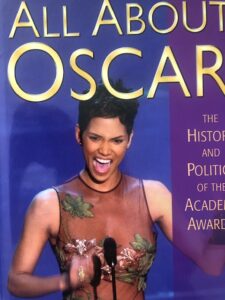King Vidor was nominated five times for the Best Director Oscar, but he had never won a legitimate one.
In 1979, he received an Honorary Oscar for his “incomparable achievements as a cinematic creator and innovator.”
Vidor’s best known films include:
The Big Parade (1925), The Crowd (1928), Hallellujah! (1929) The Champ (1931), Our Daily Bread (1934), Stella Dallas (1937), The Citadel (1938) Duel in the Sun (1946), The Fountainhead (1949), War and Peace (1956).
Vidor was born February 8, 1894 in Galveston, Texas, where he survived the great Galveston Hurricane of 1900. He later published a fictionalized account of that cyclone, titled “Southern Storm,” in the May 1935 issue of Esquire.
A freelance newsreel cameraman and projectionist, Vidor made his debut as a director in 1913 with The Grand Military Parade.
First Feature
In Hollywood from 1915, he worked as a screenwriter and director of a series of six short juvenile-delinquency films for Judge Willis Brown.
He directed his first feature, The Turn in the Road, in 1919.
Peg o’ My Heart in 1922 won him a contract with the Goldwyn Studios (later to be absorbed into MGM).
Three years later he made The Big Parade, among the most acclaimed war films of the silent era, and a commercial success. This film established him as one of MGM’s top directors for the next decade.
In 1928, Vidor received his first Oscar nomination, for The Crowd, one of the greatest American silent films.
In the same year, he made Show People, a comedy about the film industry starring Marion Davies, and the screwball comedy, The Patsy, which also starred Davies and was his last silent film.
First Sound Feature
Vidor’s first sound work was Hallelujah!, a groundbreaking musical film with an African-American cast.
He adjusted quickly to the new technology of sound and made features until the late 1950s.
Vidor directed the Kansas sequences in The Wizard of Oz (including “Over the Rainbow” and the twister) when director Victor Fleming was asked to replace George Cukor on Gone with the Wind, but he did not receive screen credit.
Vidor is in the Guinness Book of World Records for having the longest career as a filmmaker, spanning 67 years: beginning in 1913 with the film Hurricane in Galveston and ending in 1980 with The Metaphor, a short docu about the painter Andrew Wyeth.
In 1944, Vidor joined the anti-communist Motion Picture Alliance for the Preservation of American Ideals.
Vidor published his autobiography, A Tree is a Tree, in 1953. This book’s title is inspired by an incident in Vidor’s Hollywood career. Vidor wanted to shoot in the locations where its story was set, but the producer told him, “A rock is a rock. A tree is a tree. Shoot it in Griffith Park.”
He died at the age of 85 of heart ailment at his home in Westwood, California on November 1, 1982.
Career Analysis:
Director of both silent and sound features
Output: over 50 features
Silent:
Sound films: 30 features
Career span: long, prolific career, spanning four decades
Oscar Nominations: 5
Oscar wins: 0
Span of nominations (from first nomination to last): 28 years
Filmography
Silent Features (Incomplete)
The Big Parade (1925)
La Bohème (1926)
Bardelys the Magnificent (1926)
The Crowd (1928)
The Patsy, also known as The Politic Flapper (1928)
Show People (1928)
Sound Films: 30 features
Hallelujah! (1929)
Not So Dumb (1930)
Billy the Kid (1930)
Street Scene (1931)
The Champ (1931)
Bird of Paradise (1932)
Cynara (1932) US reissue title I Was Faithful
The Stranger’s Return (1933)
Our Daily Bread (1934)
The Wedding Night (1935)
So Red the Rose (1935)
The Texas Rangers (1936)
Stella Dallas (1937)
The Citadel (1938)
The Wizard of Oz (1939) (Kansas scenes only) (uncredited)
Northwest Passage (1940)
Comrade X (1940)
H.M. Pulham, Esq. (1941)
An American Romance (1944)
Duel in the Sun (1946); huge commercial hit
On Our Merry Way, A Miracle Can Happen (1948)
The Fountainhead (1949)
Beyond the Forest (1949)
Lightning Strikes Twice (1951)
Japanese War Bride (1952)
Ruby Gentry (1952)
Light’s Diamond Jubilee (1954) (TV)
Man Without a Star (1955)
War and Peace (1956), fifth and last best director nod
Solomon and Sheba (1959)
Truth and Illusion (1964)
The Metaphor (1980) (short docu)




